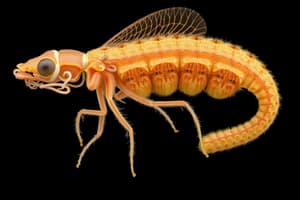Podcast
Questions and Answers
What is the process of grouping things based upon?
What is the process of grouping things based upon?
- Biology
- Classification (correct)
- Nomenclature
- Taxonomy
What is taxonomy?
What is taxonomy?
The study of how organisms are classified based on structural characteristics and genetic comparisons.
What is binominal nomenclature?
What is binominal nomenclature?
Giving each organism a two-word scientific name using their genus and species.
What does taxa (Taxon) refer to?
What does taxa (Taxon) refer to?
Prokaryotic organisms have a nucleus.
Prokaryotic organisms have a nucleus.
Eukaryotic cells are characterized by the presence of membrane-bound organelles.
Eukaryotic cells are characterized by the presence of membrane-bound organelles.
What is a heterotroph?
What is a heterotroph?
What is an autotroph?
What is an autotroph?
A unicellular organism consists of multiple cells.
A unicellular organism consists of multiple cells.
Multicellular organisms are composed of many cells.
Multicellular organisms are composed of many cells.
What domain includes the kingdom Archaebacteria?
What domain includes the kingdom Archaebacteria?
What domain includes the kingdom Eubacteria?
What domain includes the kingdom Eubacteria?
What domain includes kingdoms of all eukaryotes?
What domain includes kingdoms of all eukaryotes?
What characterizes Archaebacteria?
What characterizes Archaebacteria?
What are the characteristics of Eubacteria?
What are the characteristics of Eubacteria?
What kingdom is characterized by having a nucleus and is unicellular?
What kingdom is characterized by having a nucleus and is unicellular?
What are the characteristics of fungi?
What are the characteristics of fungi?
What are the characteristics of Plantae?
What are the characteristics of Plantae?
What are the characteristics of Animalia?
What are the characteristics of Animalia?
What does 'primitive' refer to in biological terms?
What does 'primitive' refer to in biological terms?
What is a cladogram?
What is a cladogram?
How many different organisms have scientists discovered and named?
How many different organisms have scientists discovered and named?
What does 'taxa' refer to?
What does 'taxa' refer to?
Order the classification from smallest to largest taxa: ___; phylum; class; order; family; genus; species.
Order the classification from smallest to largest taxa: ___; phylum; class; order; family; genus; species.
What is the smallest and most specific category in classification?
What is the smallest and most specific category in classification?
What is a genus?
What is a genus?
Species are defined as organisms with different shapes and structures.
Species are defined as organisms with different shapes and structures.
What is a scientific name composed of?
What is a scientific name composed of?
What comparisons more accurately tell how closely related organisms are?
What comparisons more accurately tell how closely related organisms are?
What determines the domain to which organisms belong?
What determines the domain to which organisms belong?
What are kingdoms based on?
What are kingdoms based on?
What language is used to give scientific names of all living things?
What language is used to give scientific names of all living things?
What is the largest group in the current system of classification?
What is the largest group in the current system of classification?
Which Taxon includes a larger number of species?
Which Taxon includes a larger number of species?
Study Notes
Classification and Taxonomy
- Classification refers to grouping organisms based on shared characteristics.
- Taxonomy is the scientific study focused on classifying organisms through structural traits and genetic data.
Naming Organisms
- Binomial nomenclature is a two-word naming system for organisms, combining genus and species names.
- Scientific names are typically derived from Latin.
Taxonomic Hierarchy
- Organisms are categorized in a hierarchical system: domain > kingdom > phylum > class > order > family > genus > species.
- The smallest taxonomic unit is species, defined by organisms' ability to reproduce and create fertile offspring.
Cellular Structure
- Prokaryotic cells lack a nucleus and membrane-bound organelles, exemplified by bacteria.
- Eukaryotic cells contain a nucleus and organelles, represented by plants and animals.
Nutrition Types
- Heterotrophs obtain food by consuming other organisms, known as consumers.
- Autotrophs produce their own energy through processes like photosynthesis, recognized as producers.
Organism Types
- Unicellular organisms consist of a single cell, while multicellular organisms are composed of multiple cells.
Domains of Life
- Archaea is a domain that encompasses the kingdom Archaebacteria, consisting of unicellular organisms without a nucleus.
- Bacteria includes the kingdom Eubacteria, representing common unicellular bacteria.
- Eukarya includes all eukaryotic organisms, subdivided into kingdoms: Protista, Fungi, Plantae, and Animalia.
Kingdom Characteristics
- Archaebacteria: unicellular, no nucleus, resembles early Earth life forms.
- Eubacteria: unicellular, no nucleus, includes common modern bacteria.
- Protista: eukaryotic and mostly unicellular organisms.
- Fungi: eukaryotic, heterotrophic, largely multicellular, with cell walls made of chitin.
- Plantae: eukaryotic, autotrophic, multicellular, with cell walls made of cellulose; includes mosses and flowering plants.
- Animalia: eukaryotic, multicellular, heterotrophic, no cell walls; includes diverse life forms from sponges to mammals.
Evolutionary Relationships
- Cladograms visually represent evolutionary relationships among organisms, showing common ancestors.
Scientific Progress
- Approximately 2 million species recognized; the discovery of new organisms is an ongoing process.
- DNA and protein comparisons provide deeper insights into the relationships between organisms.
Language and Classification
- Latin is the standardized language for formatting scientific names.
- Domains represent the broadest category in current classification systems, including prokaryotes (no nucleus) and eukaryotes (with nucleus).
Taxonomic Confusion
- Phylum includes more organisms than the order, as it is a broader category within the classification hierarchy.
Studying That Suits You
Use AI to generate personalized quizzes and flashcards to suit your learning preferences.
Description
Flashcards covering key terms in classification of life, including taxonomy, binominal nomenclature, and taxa.




